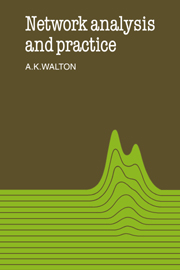Book contents
- Frontmatter
- Contents
- Preface
- 1 Electric charge, field and potential
- 2 Electric current, resistance and electromotive force
- 3 Direct-current networks
- 4 Capacitance, inductance and electrical transients
- 5 Introduction to the steady-state responses of networks to sinusoidal sources
- 6 Transformers in networks
- 7 Alternating-current instruments and bridges
- 8 Attenuators and single-section filters
- 9 Multiple-section filters and transmission lines
- 10 Signal analysis of nonlinear and active networks
- 11 Fourier and Laplace transform techniques
- 12 Filter synthesis
- Mathematical background appendices
- Problems
- Answers
- Solutions
- Index
1 - Electric charge, field and potential
Published online by Cambridge University Press: 05 June 2012
- Frontmatter
- Contents
- Preface
- 1 Electric charge, field and potential
- 2 Electric current, resistance and electromotive force
- 3 Direct-current networks
- 4 Capacitance, inductance and electrical transients
- 5 Introduction to the steady-state responses of networks to sinusoidal sources
- 6 Transformers in networks
- 7 Alternating-current instruments and bridges
- 8 Attenuators and single-section filters
- 9 Multiple-section filters and transmission lines
- 10 Signal analysis of nonlinear and active networks
- 11 Fourier and Laplace transform techniques
- 12 Filter synthesis
- Mathematical background appendices
- Problems
- Answers
- Solutions
- Index
Summary
Electric charge
Before embarking on a study of electrical networks, it is important to understand thoroughly such basic electrical concepts as charge, field, potential, electromotive force, current and resistance. The first few sections of this book are concerned with developing these concepts in a logical sequence.
Phenomena due to static electricity have been observed since very early times. According to Aristotle, Thales of Miletus (624–547 B.C.) was acquainted with the force of attraction between rubbed pieces of amber and light objects. However, it was William Gilbert (1540–1603) who introduced the word electricity from the Greek word ηλεκτρον (electron) signifying amber, when investigating this same phenomenon. Many other materials have been found to exhibit similar properties. For example, if a piece of ebonite is rubbed with fur, then on separation they attract each other. However, an ebonite rod rubbed with fur repels another ebonite rod similarly treated. Also, a glass rod rubbed with silk repels another glass rod rubbed with silk. Yet an ebonite rod that has been rubbed with fur attracts a glass rod that has been rubbed with silk.
All of these observations can be explained by stating that two kinds of electricity exist, that on glass rubbed with silk being called positive electricity and that on ebonite rubbed with fur negative electricity. In addition, like kinds of electricity repel, unlike kinds attract. Actually, all substances taken in pairs become oppositely electrified when rubbed together.
- Type
- Chapter
- Information
- Network Analysis and Practice , pp. 1 - 10Publisher: Cambridge University PressPrint publication year: 1987



